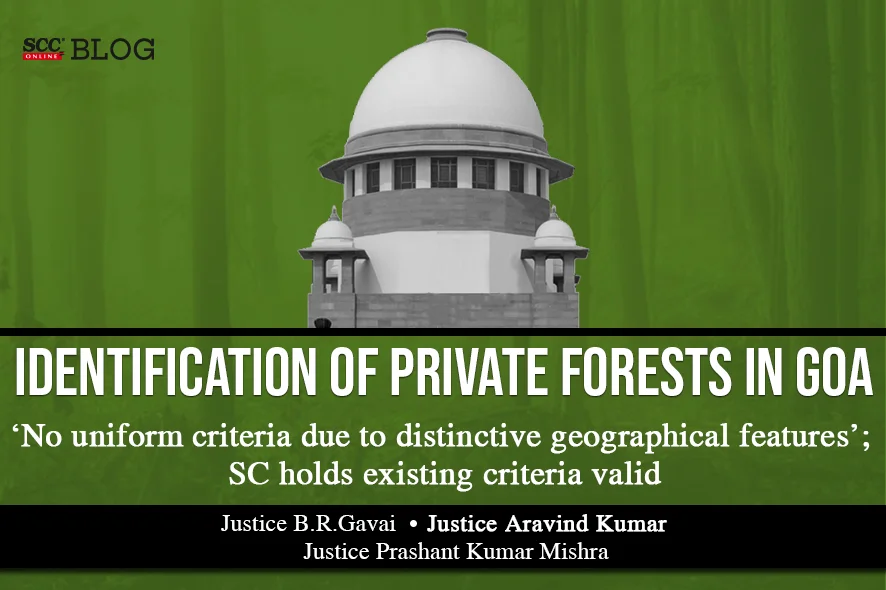Supreme Court: In a set of two civil appeals against the National Green Tribunal’s common order, wherein Goa Foundation’s (‘appellant’) application was dismissed on the ground that the issue of determination of criteria for the identification of ‘forest’ formed part of the proceedings in In Re: TN Godavarman Thirumulpad1, the three Judge Bench of B.R.Gavai, Aravind Kumar* and Prashant Kumar Mishra, JJ. dismissed the appeal and upheld the impugned Order.
Criteria for the identification of the ‘forests’ in the State of Goa
The Conservator of Forests, State of Goa, in 1991 set out the guidelines for identifying ‘forest’ in private properties, pursuant to the Judgement of the Bombay High Court in Shivanand Salgaocar v. Tree Officer2 declaring the application of the Forest (Conservation) Act, 1980 (‘FCA’) to all lands, whether government or privately owned. The guidelines were issued on criteria to implement the FCA 1980 to private forests, in line of Shivanand Salgaocar (supra). The guidelines included the extent of area; proximity and/or contiguity of the private forest; composition of crop and crown density.
Thereafter, the Government of Goa constituted the Sawant Committee in 1997 to implement the order dated 12-12-1996 in T.N. Godavarman Thirumulpad v. Union of India, (1997) 2 SCC 267 whereby, all the States were directed to constitute an expert committee for the tasks of identification of the areas which are “forests”, irrespective of whether they are so notified, recognised or classified under any law, and irrespective of the ownership of the land of such forest; identify areas which were earlier forests but stand degraded, denuded or cleared; and identify areas covered by plantation trees belonging to the Government and those belonging to private persons. Later, in 2000, the Karapurkar Committee suggested excluding some of the forest areas already identified by the Sawant Committee. Hence, the Goa Foundation filed a writ petition before the Court challenging the appointment of the Karapurkar Committee. Meanwhile, the Karapurkar Committee submitted its final report and identified 20.18 sq. kms of private forests.
Impugned Decision
The present appeal was originally filed on 19-11-2014 assailing the NGT’s final order dated 30-07-2014 whereby it was opined that it would not be in the NGT’s domain to consider and alter or newly fix the forest identification criteria.
Appeal against NGTs Order
The Court vide order dated 04-02-2015 converted the civil appeal to Interlocutory Application in the proceedings before the Court in T.N. Godavarman case (supra). The Court also issued a direction to the State of Goa to not issue any ‘No Objection Certificate’ for conversion of any plot that has natural vegetation with tree canopy density in excess of 0.1 and an area above one hectare.
The issue in the appeals revolved around the criteria for the identification of the ‘forests’ in the State.
Analysis and Decision
The Court noted that the Sawant Committee had adopted the following criteria for identifying forests and the consequent application of the FCA 1980 to private forests:
-
75 per cent of the tree composition should be forestry species.
-
The area should be contiguous to the Government Forest and if in isolation the minimum area should be five hectares;
-
The canopy density on the plot should not be less than 0.4.
Further, the Court referred to Tata Housing Development Corporation v. Goa Foundation, (2003) 11 SCC 714, wherein, the Court strongly disapproved any departure from such criteria and adoption of a new criteria.
The Court noted that the said criteria was also published in public notice dated 08-02-1997 and said that they were well within the knowledge of the appellant since they were parties to the proceedings in Tata Housing (supra). Thus, the Court estopped the appellant from raising the said issue at the present stage since no finger was raised against the criteria when they were published in the public notice dated 08-02-1997.
Regarding the concept of Net Present Value (NPV) to determine economic loss caused on account of deforestation verified by the Court in T.N. Godavarman Thirumulpad v. Union of India, (2006) 1 SCC 1 by its order dated 26-09-2005, the Court said that a Committee was constituted to formulate the base on which NPV could be calculated, and the same was fixed for a period of three years. Therefore, the Cour stated that it would not be appropriate for the Court to sit in the experts’ arm chair and to substitute their opinion.
Regarding the issue relating to identification and demarcation of private forests in the State, the Court said that it had attained finality on the above stated three criteria and the State had issued a gazette notification on 22-09-2022 notifying 46.11 sq. km. as private forest.
Further, the Court said that the application of criteria to identify forests cannot be universally standardized across the country, as it is contingent upon the specific geography and geographical conditions prevalent in each State. The Court stated that each State possesses its distinctive geographical features, and as a result, the criteria may vary from one State to another and hence.
Conclusion
Thus, the present appeals were dismissed, and the impugned order was upheld. The Court held that the existing criteria for identification of private forests in the State were adequate and valid, hence, they required no alteration.
[In Re: T.N. Godavarman Thirumulpad v. Union of India, 2024 SCC OnLine SC 65, Decided on 24-01-2024]
Judgment Authored by: Justice Aravind Kumar
1. (Writ Petition No.202 of 1995).
2. Writ Petition No.162 of 1987.






